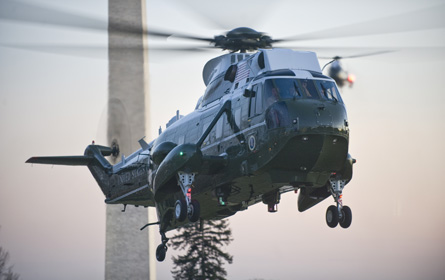The US Navy has launched the process to buy a new presidential helicopter, nine months after deciding to cancel the Lockheed Martin/AgustaWestland VH-71 despite spending $3.2 billion.
A request for information issued on 16 February asks industry to submit data about potential helicopter platforms that could fulfil the VXX mission. The results will feed an analysis of alternatives that is required before launching a competition or awarding a sole-source contract.
Such reviews generally require 12-18 months to complete at a minimum, although it is possible the USN could shorten the timeframe based on the knowledge acquired during the previous VXX programme.
The 27-page RFI document suggests the navy is considering making a major change to its acquisition strategy compared with the VH-71 process.
 |
|---|
© Greg Mathieson/Rex Features |
The USMC's VH-3Ds were delivered in the 1970s |
Rather than buy a common aircraft to replace 11 Sikorsky VH-3Ds and eight Sikorsky VH-60s, the service would consider splitting the contract with a mixed fleet, the RFI says. Options under review include buying a common aircraft with two variants, or simply purchasing two different aircraft types.
The RFI discusses buying one aircraft with a fully appointed executive suite, including galley and lavatory, and a different aircraft with a full load of command, control and communications equipment.
Its proposed change appears aimed at addressing a key reason for the cost overruns and schedule delays that plagued the terminated contract for the VH-71. The navy required Lockheed to substantially redesign the VH-71 after contract award because the aircraft was not large or powerful enough to carry everything the presidential mission needed.
 |
|---|
© Lockheed Martin |
Equipment requirements outgrew the AW101 airframe, despite a $3.2 billion spend |
The original competition for the VXX contract became a heated race between Sikorsky's "All-American" VH-92 and the Lockheed team's VH-71, which is based on the AgustaWestland AW101.
The second round of bids is expected to include a challenge from Boeing, which has discussed offering a variant of its CH-47 Chinook or the Bell Boeing V-22 Osprey tiltrotor. However, the RFI suggests that the latter type could be disadvantaged in the new competition, as the navy requires a speed of 140kt (260km/h), or roughly half of the V-22's capability.
Meanwhile, the USN has revealed plans to invest $500 million to keep the current presidential helicopter fleet serviceable until the long-awaited replacement arrives. The VH-3Ds have been in service for nearly 40 years, while the VH-60s became operational in the late 1980s.
Source: Flight International



















